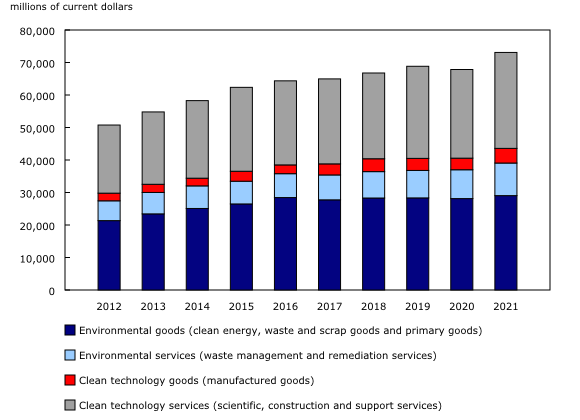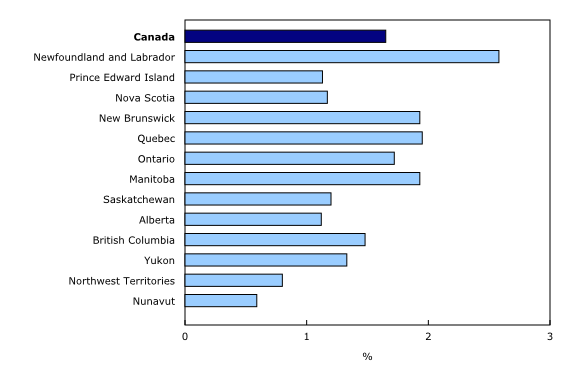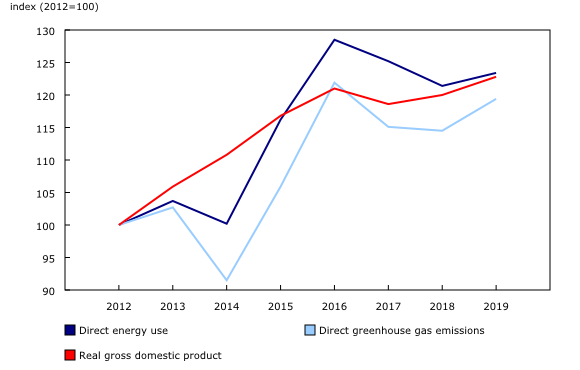Environmental and Clean Technology Products Economic Account, 2021
Released: 2022-12-19
The real gross domestic product (GDP) generated by the environmental and clean technology products sector increased slightly in 2021, a 0.8% gain from 2020, following a 2.9% decline in 2020 from 2019. The real GDP of the total Canadian economy grew 5.0% in 2021.
In nominal terms, the value of the environmental and clean technology products sector in Canada increased from $67.8 billion in 2020 to $73.1 billion in 2021, accounting for 2.9% of Canada's GDP. The sector's share of national GDP has remained relatively stable since the beginning of this time series in 2007.
The GDP shares of the three main provincial contributors to the environmental and clean technology products sector—Ontario, Quebec and British Columbia—have also remained stable since 2007. In 2021, Ontario (34.5%) accounted for over one-third of the sector, while Quebec (29.8%) accounted for over one-quarter and British Columbia (15.1%) accounted for one-seventh.
In 2021, just over half (53.5%) of the national environmental and clean technology products sector's GDP was attributable to the production of environmental goods and services. The remaining 46.5% was attributable to the production of clean technology goods and services.
The Environmental and Clean Technology Products Economic Account (ECTPEA) measures the production of goods and services that reduce environmental impacts' contribution to the Canadian economy. Two broad categories of goods and services are recognized: environmental goods and services (including clean electricity from renewable sources and nuclear power generation, biofuels and primary goods, and waste management and remediation services) and clean technology goods and services (including manufactured goods, scientific and research and development services, construction services, and support services). Examples of clean technology goods and services include solar panels and the design and construction of energy-efficient buildings.
The environmental and clean technology products sector gross domestic product impacted by decline in the production of clean electricity
The growth observed in the clean technology products subsector's national real GDP (3.7%) was offset by a decrease in the environment products subsector's real GDP (-1.5%) in 2021. The environmental products subsector accounted for a larger share of the sector's GDP compared with clean technology products. The generation of clean electricity, which is a significant contributor to the sector's GDP, saw its GDP decrease by 3.7% from 2020.
Most environmental and clean technology product exports and imports are manufactured goods
The volume of environmental and clean technology products exports increased 0.5% from 2020 to 2021. In nominal terms, the value of these exports totalled $17.9 billion in 2021.
As in 2020, clean technology products (mostly manufactured goods) represented just over half (51.4%, or $9.2 billion) of all environmental and clean technology products exports in 2021. Waste and scrap goods for recycling exports accounted for 27.6% of the value of the sector's exports, and clean electricity accounted for 14.0% of exports. The volume of clean electricity exports declined 15.1% in 2021.
National environmental and clean technology products imports volume increased 6.4% in 2021, following a slight increase (+1.5%) in 2020. The gain may reflect a return to levels seen before the COVID-19 pandemic for businesses, possibly due to fewer disruptions to worldwide supply chains.
The total value of Canadian environmental and clean technology products imports (in nominal terms) amounted to $21.8 billion in 2021. Manufactured goods accounted for 64.1% of that total, at $14.0 billion.
Employment increases
An estimated 314,257 jobs were attributable to the environmental and clean technology products sector in 2021, up 6.5% from 2020, accounting for 1.6% of all jobs in Canada in 2021. By comparison, over the same period, total Canadian jobs increased 8.5%.
Of these 314,257 jobs attributed to the environmental and clean technology products sector, 188,794 jobs were dedicated to the production and delivery of clean technology goods and services. The remaining 125,463 jobs were related to the production and delivery of environmental goods and services.
The utilities industry was the largest industry group in terms of employment, accounting for over one-fifth (65,656) of environmental and clean technology jobs in 2021. These jobs were mainly found in the electric power generation, transmission and distribution industry group.
The national average annual compensation per environmental and clean technology job, including benefits, declined 0.6% from 2020 to $96,910 in 2021, compared with an economy-wide average of $69,311 (up 0.9% from 2020).
New linked data show energy use and real gross domestic product for the environmental and clean technology products sector increasing at similar rates; greenhouse gas emissions increasing more slowly
Also released today are new estimates that present the direct energy use and greenhouse gas (GHG) emissions associated with production in the environmental and clean technology products sector.
The 23.3% increase in national GDP (in constant dollars) of the sector from 2012 to 2019 coincided with a 23.4% increase in energy directly consumed and a 19.4% increase in GHGs directly emitted during production.
While this sector's energy use and GHG emissions mostly followed economic output during the series, the environmental and economic trends diverged in 2014 and 2016. In 2019, both energy used and kilotonnes of GHGs emitted approached their previous peaks from 2016.
These new data are the result of linking the ECTPEA with Statistics Canada's Physical Flow Account on energy use and GHG emissions. This linkage is the first of a series undertaken in collaboration with the Canadian Centre for Energy Information.
Note to readers
The Environmental and Clean Technology Products Economic Account (ECTPEA) measures the economic contribution of environmental and clean technology products in terms of output, gross domestic product (GDP), employment (number of jobs) and other economic variables. Estimates are directly comparable with national results for the Canadian economy. Estimates of GDP referred to in this release are measured at basic prices.
Estimates for 2020 and 2021 are preliminary and will be revised when updated data become available, including the supply and use tables for those reference years.
Environmental and clean technology products are defined as any process, product or service that reduces environmental impacts through any of the following three strategies: environmental protection activities that prevent, reduce or eliminate pollution or any other degradation of the environment; resource management activities that result in the more efficient use of natural resources, thus safeguarding against their depletion; the use of goods that have been adapted to be significantly less energy or resource intensive than the industry standard.
Two broad categories of environmental and clean technology products are recognized: environmental goods and services (including clean electricity, biofuels and primary goods, and waste management and remediation services) and clean technology goods and services (including manufactured goods, scientific and research and development services, construction services, and support services). The products follow the Supply and Use Product Classification used in the Canadian System of Macroeconomic Accounts.
In December 2022, datasets were revised from reference year 2012 to include waste and scrap goods for recycling in the environmental product subsector. This product was originally reported in the clean technology products subsector. As information on waste and scrap goods is not available from 2007 to 2011, revisions could not be applied to these years. Waste and scrap goods are therefore conceptually accounted in clean technology products subsector for those years.
As part of the Government of Canada's initiative to develop the Clean Technology Data Strategy, the ECTPEA provides comprehensive measures of the supply and use of environmental and clean technology products in the Canadian economy. The ECTPEA has a broader scope than the Survey of Environmental Goods and Services because it captures all economy-wide transactions in the environmental and clean technology products sector, including elements such as clean energy and scrap goods. The government and non-profit sectors are also fully covered in the ECTPEA.
The compilation of the ECTPEA draws on a variety of data sources, including Statistics Canada's supply and use tables, detailed import and export statistics released in Canada's balance of international payments and the Survey of Environmental Goods and Services.
Examples of environmental goods and services and clean technologies are available in the publication Clean technologies and the Survey of Environmental Goods and Services: A technical reference guide (16-511-X).
Contact information
For more information, or to enquire about the concepts, methods or data quality of this release, contact us (toll-free 1-800-263-1136; 514-283-8300; infostats@statcan.gc.ca) or Media Relations (statcan.mediahotline-ligneinfomedias.statcan@statcan.gc.ca).
- Date modified:



